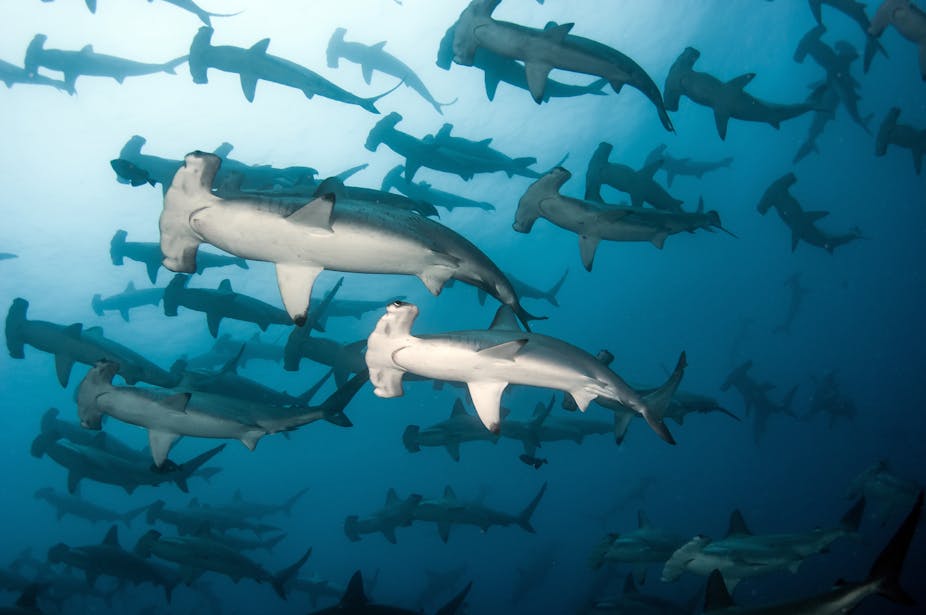Unlike nearly every other species of shark, scalloped hammerheads are highly social. They gather in large groups, or aggregations, numbering in the hundreds. But why? We don’t know.
With the help of drones, we now know a bit more. In our new research, we describe finding a location in a marine park off the coast of Perth where juvenile scalloped hammerheads (Sphyrna lewini) gather in numbers.
Scalloped hammerheads – one of ten species in the hammerhead family – prefer warm waters. But they have become regular visitors to the waters off Perth in summer, now the southernmost part of their range. The sharks are not considered dangerous to humans.
These iconic sharks are among the world’s most threatened species due to over-fishing. And incredibly they are still legally fished in Australia, despite their populations falling by 80% in just 55 years.
They are in danger unless we protect them.

What’s special about these oceanic wayfarers?
Scalloped hammerheads are named for the dents on their hammer-shaped head or cephalofoil. They’re skilled long-distance swimmers and exceptional free divers, able to hunt in the dark waters 500 metres below the surface. They grow slowly and live for up to 55 years.
Read more: Why do hammerhead sharks have hammer-shaped heads?
They’re a challenging species to study because they cover long distances and spend lots of time down deep. Finding a place where these sharks regularly aggregate offers us a remarkable opportunity to learn more about these oceanic wayfarers.

How did we find them?
Small commercial drones are revolutionising the way we study marine wildlife – especially sharks. The aerial perspective lets us see things we couldn’t see before. Drones have shed light on elusive behaviours we have otherwise been unable to verify. Footage can also be used to identify, count and measure animals.
We heard surf lifesavers had observed hammerhead sharks off Perth beaches during their helicopter shark patrols. We began our search at the Shoalwater Islands Marine Park, off the coast from Rockingham, in Perth’s southern suburbs.
Over two successive summers, we used drones to successfully spot and then track scalloped hammerheads as they aggregated inside the marine park.

What did we learn?
We learned many things. First, the scalloped hammerheads aggregating at the marine park were juveniles, not adults.
We only found them in a small area of the marine park. They were present with the full moon.
Once aggregated, they would swim in formation, moving in winding patterns through the shallow waters of the marine park.
In terms of what were they doing, our study suggest they’re seeking a place to rest and recover. Sharks often hunt more on the nights with a full moon, taking advantage of better light to see prey.
That would mean these juveniles are tired after a night’s hunting. Now they need to rest and digest. Gathering in a group could also provide some degree of protection from other predators in the area.
It’s likely, therefore, these shallow waters are important shelter for scalloped hammerheads.

How can we protect them?
Our research points to the urgent need to strengthen protection of scalloped hammerheads in the popular Shoalwater Islands Marine Park.
We need a code of conduct to prevent water users such as boaters, kayakers, and swimmers from disturbing the animals, similar to those protecting whale sharks and humpback whales. Boat speed limits and bans on chasing animals are essential if we are to protect these endangered animals.
Stopping fishing at the aggregation site is vitally important. Hammerheads are extremely vulnerable to any capture and are unlikely to survive “catch and release” fishing. The marine park should be a safe spot for the sharks to shelter and rest.
We need to strengthen protections in the marine park, shifting from multiple use status – which allows fishing – to highly protected, which prohibits fishing.
Right now, the federal government is reviewing the status of these sharks. Given ongoing fishing pressure, there are clear reasons to assess them as endangered rather than their unclear status as “conservation dependent”.
Australia is fortunate to host remarkable and endangered species such as hammerhead sharks. As our understanding grows, so does our responsibility. There are simple steps available to the state and federal government to safeguard the future of this threatened species and maintain healthy marine ecosystems.
Read more: Some sharks have declined by 92% in the past half-century off Queensland's coast

